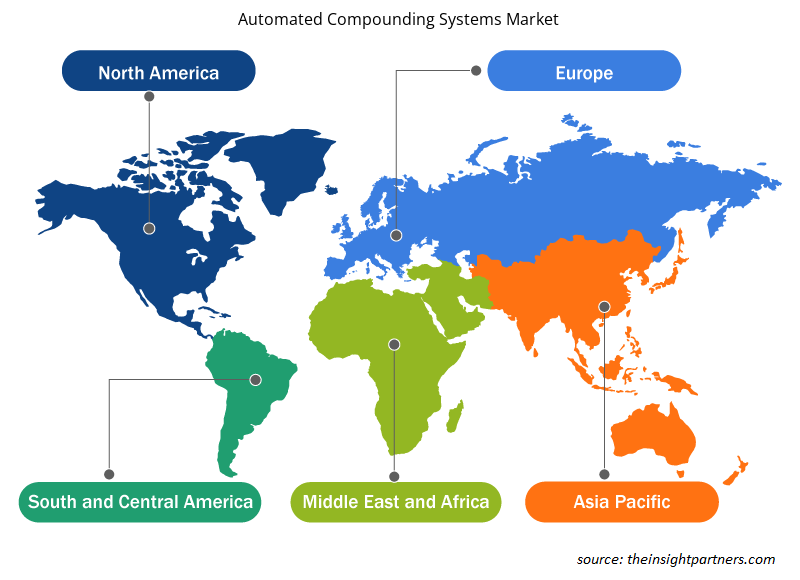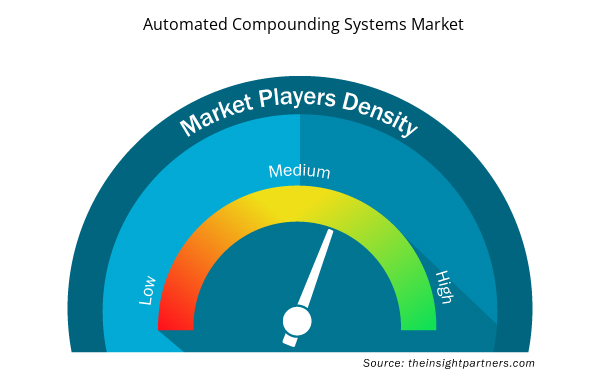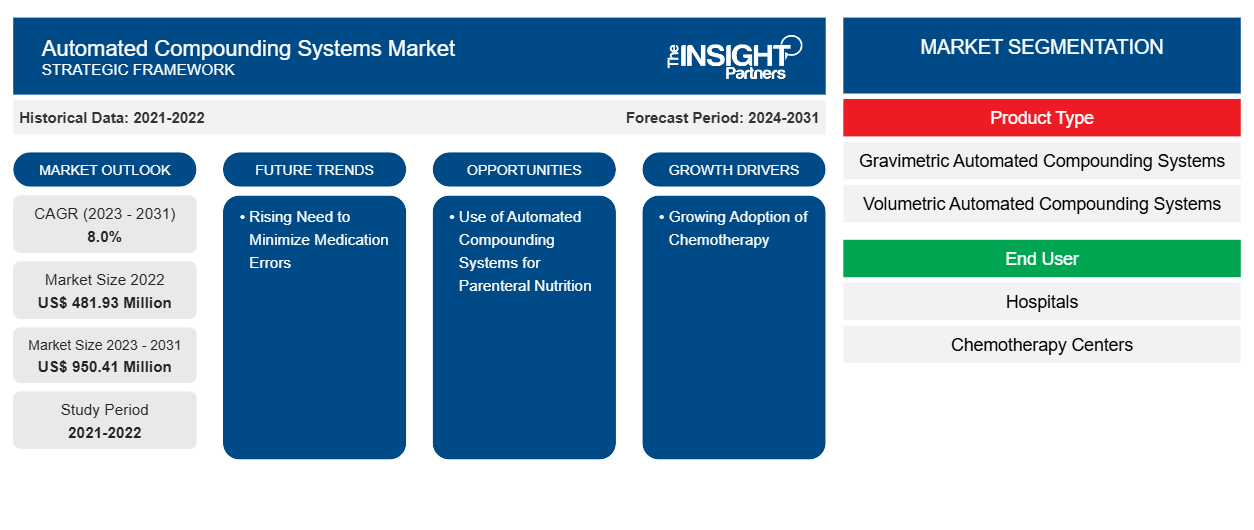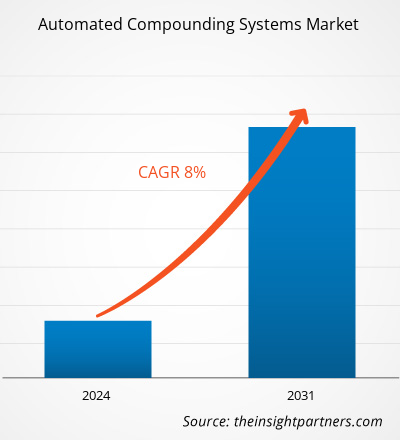自動配合システム市場規模は、2022年には4億8,193万米ドル、2023年にはXX百万米ドルと推定され、2031年までに9億5,041万米ドルに達すると予想されています。また、2031年まで8.0%のCAGRを記録すると予測されています。戦略的開発と製品の発売は、自動配合システム市場の主要トレンドであり続けると思われます。
自動配合システム市場分析
パーソナライズされた医薬品の需要の増加、患者の安全性の向上、薬剤調合に関する厳格な規制、自動調合システムの効率性と費用対効果、薬剤師の意識の高まりが、自動調合システム市場の成長を牽引しています。さらに、慢性疾患の罹患率の増加も、自動調合システムの需要を後押ししています。
自動配合システム市場の概要
自動調剤システムは、医師と薬剤師の間の管理上のコミュニケーション不足、薬局での保管方法の厳格化、類似ラベルの使用による混乱など、さまざまな要因によって発生する投薬ミスを回避するのに役立ちます。さらに、自動調剤システムにより、調剤製品の調合の精度と効率が向上し、医療従事者の毒性物質への曝露がさらに減少しました。
要件に合わせてレポートをカスタマイズする
このレポートの一部、国レベルの分析、Excelデータパックなど、あらゆるレポートを無料でカスタマイズできます。また、スタートアップや大学向けのお得なオファーや割引もご利用いただけます。
- このレポートの主要な市場動向を入手してください。この無料サンプルには、市場動向から見積もりや予測に至るまでのデータ分析が含まれます。
自動配合システム市場の推進要因と機会
投薬ミスを最小限に抑える必要性の高まり
投薬および調剤ミスは、世界中で入院再発の主な問題です。投薬ミスは、患者ケアのさまざまなレベルで医療従事者と医療補助従事者の両方によって発生する可能性があります。投薬ミスは、医師と薬剤師の間の注文のコミュニケーション不足、ドラッグストアでの危険な保管方法、同じラベルの使用による誤解など、いくつかの要因により発生する可能性があります。したがって、マルチレベルの監視が必須です。自動調剤システムは、これらのミスを減らすための最も適切なソリューションの1つとして検討されています。さまざまな政府機関が投薬ミスを回避するための対策に取り組んでおり、患者に適切な投薬を提供するためにこれらのミスを克服する方法とシステムを開発しています。したがって、投薬および調剤ミスを最小限に抑えるために、いくつかの国の政府は、薬局や病院での自動調剤および投薬ツールの使用を奨励しています。これは、自動調剤システム市場の成長を促進する主要な要因であると考えられています。
非経口栄養のための自動調合システムの使用 - 自動調合システム市場の機会
非経口栄養は、がんや消化管に影響を与える慢性疾患などの病気により患者が栄養ニーズを満たすことができない場合に適応されます。このタイプの栄養は、重症短腸症候群 (SBS) のほとんどの患者にとって治療の要です。SBS は年間 100 万人あたり約 3 人に発生します。 2020年に発表された「短腸症候群を理解する:現状と将来の展望」という記事によると、SBSの有病率は過去40年間で2倍以上に増加しています。有病率は米国では100万人あたり約30例、ヨーロッパでは100万人あたり約1.4例でした。自動調合システムは、非経口栄養製品の製造に使用できます。自動調合システムは通常、PN製剤に関する情報を電子的に転送する専用ソフトウェアにリンクされています。多くの研究者が、自動調合システムと手動の方法によって調製されたPN製剤を比較しています。PNの調合に自動調合システムを使用するための進行中の研究は、自動調合システム市場の成長の機会を生み出すと期待されています。
自動配合システム市場レポートのセグメンテーション分析
自動調合システム市場分析の導出に貢献した主要なセグメントは、投与経路、アプリケーション、およびエンドユーザーです。
- 製品タイプに基づいて、自動配合システム市場は、重量自動配合システムと容積自動配合システムに分類されます。重量自動配合システムセグメントは、2023年に最大の市場シェアを占めました。
- エンドユーザー別に見ると、自動調合システム市場は病院、化学療法センター、その他に分類されます。病院セグメントは2023年に最大の市場シェアを占めました。
自動配合システムの地域別市場シェア分析
自動配合システム市場レポートの地理的範囲は、主に北米、アジア太平洋、ヨーロッパ、中東およびアフリカ、南米および中米の 5 つの地域に分かれています。
北米は自動調合システム市場を支配してきました。北米の市場成長は、慢性疾患治療薬の需要増加、主要な市場プレーヤーの存在、米国での自動調合システムの採用増加に伴う製品発売の増加、医薬品の自動充填および包装の需要増加につながる医薬品生産の増加、学術研究機関および製薬会社による広範な研究開発によって特徴付けられます。さらに、アジア太平洋地域は今後数年間で最高のCAGRを記録すると予想されています。
自動配合システム市場の地域別分析
予測期間を通じて自動配合システム市場に影響を与える地域的な傾向と要因は、Insight Partners のアナリストによって徹底的に説明されています。このセクションでは、北米、ヨーロッパ、アジア太平洋、中東、アフリカ、南米、中米にわたる自動配合システム市場のセグメントと地理についても説明します。

- 自動配合システム市場の地域別データを入手
自動配合システム市場レポートの範囲
| レポート属性 | 詳細 |
|---|---|
| 2022年の市場規模 | 4億8,193万米ドル |
| 2031年までの市場規模 | 9億5,041万米ドル |
| 世界のCAGR(2023年~2031年) | 8.0% |
| 履歴データ | 2021-2022 |
| 予測期間 | 2024-2031 |
| 対象セグメント | 製品タイプ別
|
| 対象地域と国 | 北米
|
| 市場リーダーと主要企業プロフィール |
|
自動配合システム市場のプレーヤー密度:ビジネスダイナミクスへの影響を理解する
自動配合システム市場は、消費者の嗜好の変化、技術の進歩、製品の利点に対する認識の高まりなどの要因により、エンドユーザーの需要が高まり、急速に成長しています。需要が高まるにつれて、企業は提供を拡大し、消費者のニーズを満たすために革新し、新たなトレンドを活用し、市場の成長をさらに促進しています。
市場プレーヤー密度とは、特定の市場または業界内で活動している企業または会社の分布を指します。これは、特定の市場スペースに、その規模または総市場価値と比較して、どれだけの競合相手 (市場プレーヤー) が存在するかを示します。
自動配合システム市場で事業を展開している主要企業は次のとおりです。
- シンプリビア
- バクスターインターナショナル株式会社
- ブラウン・メルズンゲンAG
- コマーシャル
- ICUメディカル株式会社
- グリフォルス、SA
免責事項:上記の企業は、特定の順序でランク付けされていません。

- 自動配合システム市場のトップキープレーヤーの概要を入手
自動配合システム市場のニュースと最近の動向
自動調合システム市場は、重要な企業出版物、協会データ、データベースを含む一次調査と二次調査後の定性的および定量的データを収集することによって評価されます。以下は、自動調合システムと戦略の市場における動向のリストです。
- Simplivia は、最先端の Chemfort クローズド システム薬剤移送装置 (CSTD) を搭載した革新的な SmartCompounders 化学療法自動化ソリューションをリリースしました。このソリューションは、薬剤師と技術者に、調剤プロセスをより短く、より信頼できるものにし、薬剤の識別と投薬量の誤りを排除するためのツールを提供します。(出典: Simplivia、企業 Web サイト、2024 年)
- Baxter International Inc は、ExactaMix Pro 自動調合機を発売しました。ExactaMix Pro は、ExactaMix と比較して、強化されたセキュリティと、より直感的で効率的な機能、およびより優れた処理能力を兼ね備えています。(出典: Baxter、会社 Web サイト、2022 年)
自動配合システム市場レポートの対象範囲と成果物
「自動配合システム市場規模と予測(2021〜2031年)」レポートでは、以下の分野をカバーする市場の詳細な分析を提供しています。
- 対象範囲に含まれるすべての主要市場セグメントの世界、地域、国レベルでの市場規模と予測
- 市場の動向(推進要因、制約、主要な機会など)
- 今後の主な動向
- 詳細なPEST/ポーターの5つの力とSWOT分析
- 主要な市場動向、主要プレーヤー、規制、最近の市場動向を網羅した世界および地域の市場分析
- 市場集中、ヒートマップ分析、主要プレーヤー、最近の動向を網羅した業界の状況と競争分析
- 詳細な企業プロフィール
- 過去2年間の分析、基準年、CAGRによる予測(7年間)
- PEST分析とSWOT分析
- 市場規模価値/数量 - 世界、地域、国
- 業界と競争環境
- Excel データセット



Report Coverage
Revenue forecast, Company Analysis, Industry landscape, Growth factors, and Trends

Segment Covered
This text is related
to segments covered.

Regional Scope
North America, Europe, Asia Pacific, Middle East & Africa, South & Central America

Country Scope
This text is related
to country scope.
Trends and growth analysis reports related to Life Sciences : READ MORE..
The Insight Partners performs research in 4 major stages: Data Collection & Secondary Research, Primary Research, Data Analysis and Data Triangulation & Final Review.
- Data Collection and Secondary Research:
As a market research and consulting firm operating from a decade, we have published and advised several client across the globe. First step for any study will start with an assessment of currently available data and insights from existing reports. Further, historical and current market information is collected from Investor Presentations, Annual Reports, SEC Filings, etc., and other information related to company’s performance and market positioning are gathered from Paid Databases (Factiva, Hoovers, and Reuters) and various other publications available in public domain.
Several associations trade associates, technical forums, institutes, societies and organization are accessed to gain technical as well as market related insights through their publications such as research papers, blogs and press releases related to the studies are referred to get cues about the market. Further, white papers, journals, magazines, and other news articles published in last 3 years are scrutinized and analyzed to understand the current market trends.
- Primary Research:
The primarily interview analysis comprise of data obtained from industry participants interview and answers to survey questions gathered by in-house primary team.
For primary research, interviews are conducted with industry experts/CEOs/Marketing Managers/VPs/Subject Matter Experts from both demand and supply side to get a 360-degree view of the market. The primary team conducts several interviews based on the complexity of the markets to understand the various market trends and dynamics which makes research more credible and precise.
A typical research interview fulfils the following functions:
- Provides first-hand information on the market size, market trends, growth trends, competitive landscape, and outlook
- Validates and strengthens in-house secondary research findings
- Develops the analysis team’s expertise and market understanding
Primary research involves email interactions and telephone interviews for each market, category, segment, and sub-segment across geographies. The participants who typically take part in such a process include, but are not limited to:
- Industry participants: VPs, business development managers, market intelligence managers and national sales managers
- Outside experts: Valuation experts, research analysts and key opinion leaders specializing in the electronics and semiconductor industry.
Below is the breakup of our primary respondents by company, designation, and region:

Once we receive the confirmation from primary research sources or primary respondents, we finalize the base year market estimation and forecast the data as per the macroeconomic and microeconomic factors assessed during data collection.
- Data Analysis:
Once data is validated through both secondary as well as primary respondents, we finalize the market estimations by hypothesis formulation and factor analysis at regional and country level.
- Macro-Economic Factor Analysis:
We analyse macroeconomic indicators such the gross domestic product (GDP), increase in the demand for goods and services across industries, technological advancement, regional economic growth, governmental policies, the influence of COVID-19, PEST analysis, and other aspects. This analysis aids in setting benchmarks for various nations/regions and approximating market splits. Additionally, the general trend of the aforementioned components aid in determining the market's development possibilities.
- Country Level Data:
Various factors that are especially aligned to the country are taken into account to determine the market size for a certain area and country, including the presence of vendors, such as headquarters and offices, the country's GDP, demand patterns, and industry growth. To comprehend the market dynamics for the nation, a number of growth variables, inhibitors, application areas, and current market trends are researched. The aforementioned elements aid in determining the country's overall market's growth potential.
- Company Profile:
The “Table of Contents” is formulated by listing and analyzing more than 25 - 30 companies operating in the market ecosystem across geographies. However, we profile only 10 companies as a standard practice in our syndicate reports. These 10 companies comprise leading, emerging, and regional players. Nonetheless, our analysis is not restricted to the 10 listed companies, we also analyze other companies present in the market to develop a holistic view and understand the prevailing trends. The “Company Profiles” section in the report covers key facts, business description, products & services, financial information, SWOT analysis, and key developments. The financial information presented is extracted from the annual reports and official documents of the publicly listed companies. Upon collecting the information for the sections of respective companies, we verify them via various primary sources and then compile the data in respective company profiles. The company level information helps us in deriving the base number as well as in forecasting the market size.
- Developing Base Number:
Aggregation of sales statistics (2020-2022) and macro-economic factor, and other secondary and primary research insights are utilized to arrive at base number and related market shares for 2022. The data gaps are identified in this step and relevant market data is analyzed, collected from paid primary interviews or databases. On finalizing the base year market size, forecasts are developed on the basis of macro-economic, industry and market growth factors and company level analysis.
- Data Triangulation and Final Review:
The market findings and base year market size calculations are validated from supply as well as demand side. Demand side validations are based on macro-economic factor analysis and benchmarks for respective regions and countries. In case of supply side validations, revenues of major companies are estimated (in case not available) based on industry benchmark, approximate number of employees, product portfolio, and primary interviews revenues are gathered. Further revenue from target product/service segment is assessed to avoid overshooting of market statistics. In case of heavy deviations between supply and demand side values, all thes steps are repeated to achieve synchronization.
We follow an iterative model, wherein we share our research findings with Subject Matter Experts (SME’s) and Key Opinion Leaders (KOLs) until consensus view of the market is not formulated – this model negates any drastic deviation in the opinions of experts. Only validated and universally acceptable research findings are quoted in our reports.
We have important check points that we use to validate our research findings – which we call – data triangulation, where we validate the information, we generate from secondary sources with primary interviews and then we re-validate with our internal data bases and Subject matter experts. This comprehensive model enables us to deliver high quality, reliable data in shortest possible time.


 このレポートの無料サンプルを入手する
このレポートの無料サンプルを入手する